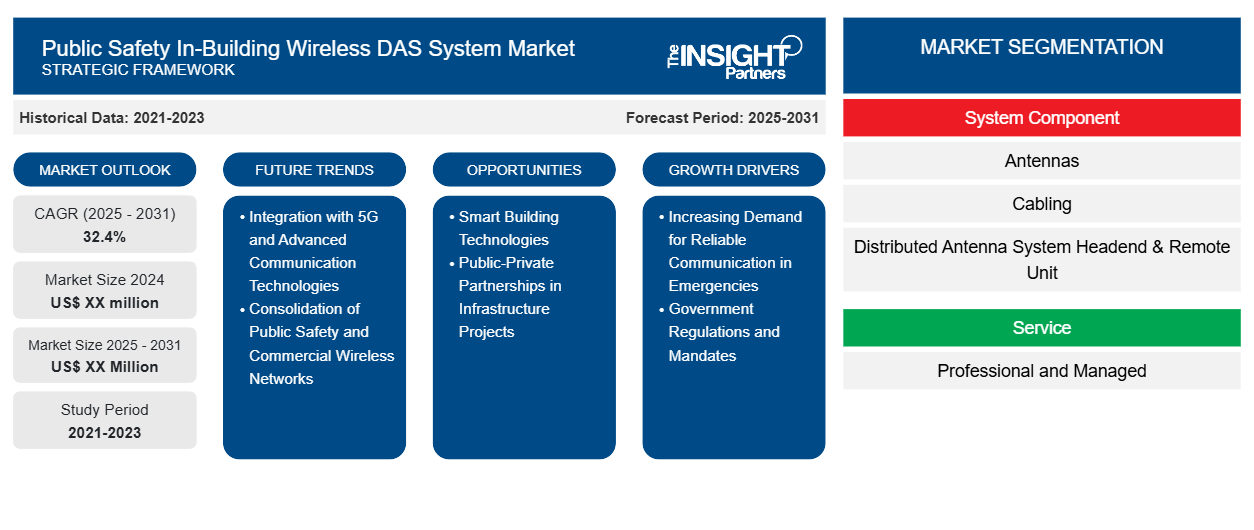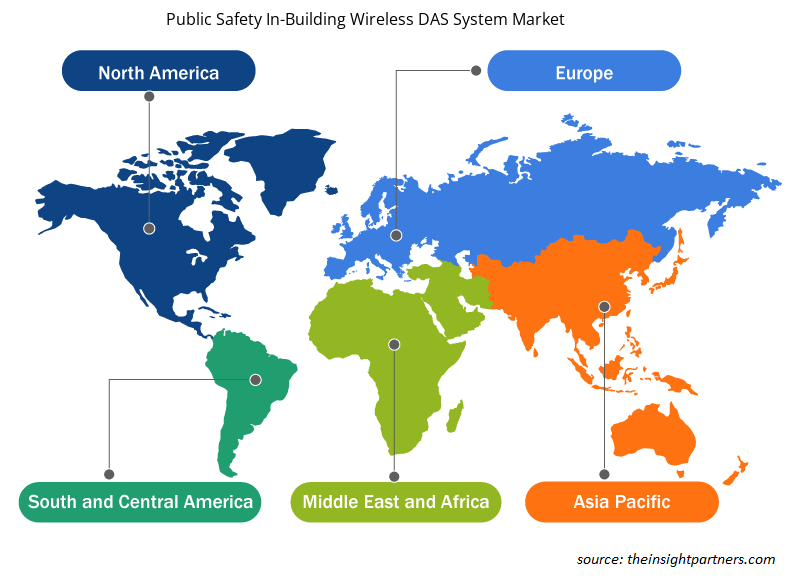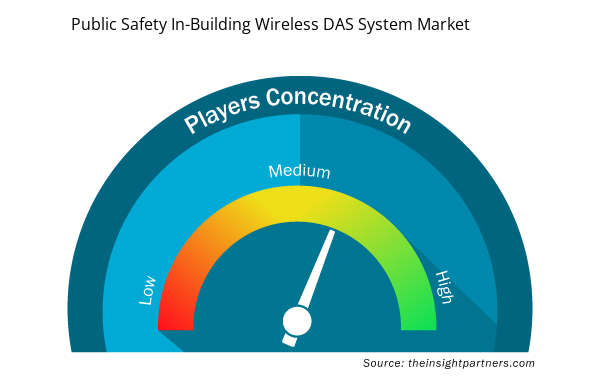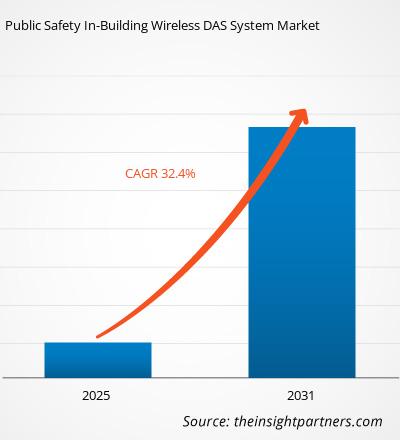Le marché des systèmes DAS sans fil pour la sécurité publique dans les bâtiments devrait enregistrer un TCAC de 32,4 % de 2024 à 2031, avec une taille de marché passant de XX millions USD en 2024 à XX millions USD d'ici 2031.DAS System Market is expected to register a CAGR of 32.4% from 2024 to 2031, with a market size expanding from US$ XX million in 2024 to US$ XX Million by 2031.
Le rapport est segmenté par composant système (antennes, câblage, tête de réseau et unité distante du système d'antennes distribuées et répéteurs) ; service (professionnel et géré) et application (complexe de bureaux d'entreprise, complexe éducatif, centres commerciaux et complexes de vente au détail, complexe de soins de santé, hôtellerie, complexe de transport, complexe religieux et autres). L'analyse globale est ensuite décomposée au niveau régional et par principaux pays. Le rapport offre la valeur en USD pour l'analyse et les segments ci-dessus
Objectif du rapport
Le rapport Public Safety In-Building Wireless DAS System Market de The Insight Partners vise à décrire le paysage actuel et la croissance future, les principaux facteurs moteurs, les défis et les opportunités. Cela fournira des informations à diverses parties prenantes commerciales, telles que :
- Fournisseurs/fabricants de technologie : pour comprendre l’évolution de la dynamique du marché et connaître les opportunités de croissance potentielles, leur permettant de prendre des décisions stratégiques éclairées.
- Investisseurs : Effectuer une analyse complète des tendances concernant le taux de croissance du marché, les projections financières du marché et les opportunités qui existent tout au long de la chaîne de valeur.
- Organismes de réglementation : Réglementer les politiques et surveiller les activités du marché dans le but de minimiser les abus, de préserver la confiance des investisseurs et de maintenir l’intégrité et la stabilité du marché.
Segmentation du marché des systèmes DAS sans fil pour la sécurité publique dans les bâtimentsDAS System Market Segmentation
Composant du système
- Antennes
- Câblage
- Tête de réseau et unité distante du système d'antenne distribuée
- Répétiteurs
Service
- Professionnel et géré
Application
- Complexe de bureaux d'entreprise
- Complexe éducatif
- Centres commerciaux et complexes commerciaux
- Complexe de santé
- Hospitalité
- Complexe de transport
- Complexe religieux
- Autres
Géographie
- Amérique du Nord
- Europe
- Asie-Pacifique
- Amérique du Sud et Amérique centrale
- Moyen-Orient et Afrique
Personnalisez ce rapport en fonction de vos besoins
Vous bénéficierez d'une personnalisation gratuite de n'importe quel rapport, y compris de certaines parties de ce rapport, d'une analyse au niveau des pays, d'un pack de données Excel, ainsi que de superbes offres et réductions pour les start-ups et les universités.
Marché des systèmes DAS sans fil pour la sécurité publique dans les bâtiments : informations stratégiques

- Obtenez les principales tendances clés du marché de ce rapport.Cet échantillon GRATUIT comprendra une analyse de données, allant des tendances du marché aux estimations et prévisions.
Facteurs de croissance du marché des systèmes DAS sans fil pour la sécurité publique dans les bâtiments
- Demande croissante de communications fiables en cas d'urgence : les premiers intervenants doivent rester connectés à tout moment afin de coordonner efficacement leurs actions en cas d'incendie, de catastrophe naturelle ou de menace pour la sécurité. Les systèmes DAS offrent une communication sans fil fiable à l'intérieur des bâtiments, même dans les régions où les matériaux comme le béton ou l'acier peuvent bloquer les signaux.
- Réglementations et mandats gouvernementaux : dans de nombreux pays, des réglementations ont été mises en place pour obliger les propriétaires d'immeubles à installer des systèmes sans fil à l'intérieur des bâtiments afin de garantir le respect des exigences en matière de communications efficaces en matière de sécurité publique. Par exemple, la FCC des États-Unis a fixé des exigences minimales en matière de puissance de signal pour les réseaux de sécurité publique, ce qui incite les propriétaires et les promoteurs immobiliers à concevoir de nouvelles constructions ou à équiper les bâtiments existants de systèmes DAS.
Tendances futures du marché des systèmes DAS sans fil pour la sécurité publique dans les bâtiments
- Intégration avec la 5G et les technologies de communication avancées : à mesure que le déploiement des réseaux 5G se développe, les systèmes DAS intégrés aux bâtiments doivent prendre en charge des vitesses plus élevées et une latence plus faible. L'avantage direct de la technologie 5G est qu'elle peut assurer le transfert en temps réel de gros volumes de données, facilitant ainsi les travaux de vidéosurveillance, les opérations de drones, les diagnostics médicaux à distance et bien d'autres tâches. Les fournisseurs de systèmes DAS créent des systèmes pour préparer les bâtiments à la communication de nouvelle génération.
- Consolidation des réseaux sans fil de sécurité publique et commerciaux : des progrès sont observés dans l'intégration des réseaux de sécurité publique aux réseaux cellulaires commerciaux. Les systèmes DAS de sécurité publique, qui existaient auparavant de manière isolée, partagent désormais de plus en plus d'infrastructures avec les réseaux commerciaux. Cette confluence se traduit par des solutions rentables et une utilisation efficace des ressources grâce au partage des réseaux cellulaires existants pour les services de sécurité publique ainsi que pour les services commerciaux.
Opportunités de marché pour les systèmes DAS sans fil pour la sécurité publique dans les bâtiments
- Technologies de bâtiment intelligent : avec l'avènement des bâtiments intelligents et l'intégration des appareils IoT, les solutions DAS peuvent s'interfacer avec d'autres systèmes de gestion de bâtiment tels que les systèmes de sécurité intelligents, les alarmes incendie et les systèmes CVC. Cela contribue à la sécurité des bâtiments, à leur efficacité et à leurs capacités de réponse rapide, ce qui constitue une opportunité pour les entreprises de se développer sur le marché des solutions combinées DAS et IoT.
- Partenariats public-privé dans les projets d’infrastructures : les gouvernements encouragent les partenariats public-privé dans le développement des infrastructures, notamment l’installation de systèmes de communication pour la sécurité publique. Ces partenariats offrent aux fournisseurs de DAS une opportunité potentielle de collaborer avec les agences gouvernementales pour installer des infrastructures de communication robustes dans des bâtiments publics neufs ou rénovés dans divers secteurs, notamment les transports, la santé et l’éducation.
Aperçu régional du marché des systèmes DAS sans fil pour la sécurité publique dans les bâtiments
Les tendances et facteurs régionaux influençant le marché des systèmes DAS sans fil pour la sécurité publique dans les bâtiments tout au long de la période de prévision ont été expliqués en détail par les analystes d’Insight Partners. Cette section traite également des segments et de la géographie du marché des systèmes DAS sans fil pour la sécurité publique dans les bâtiments en Amérique du Nord, en Europe, en Asie-Pacifique, au Moyen-Orient et en Afrique, ainsi qu’en Amérique du Sud et en Amérique centrale.

- Obtenez les données régionales spécifiques pour le marché des systèmes DAS sans fil pour la sécurité publique dans les bâtiments
Portée du rapport sur le marché des systèmes DAS sans fil pour la sécurité publique dans les bâtiments
| Attribut de rapport | Détails |
|---|---|
| Taille du marché en 2024 | XX millions de dollars américains |
| Taille du marché d'ici 2031 | XX millions de dollars américains |
| Taux de croissance annuel composé mondial (2025-2031) | 32,4% |
| Données historiques | 2021-2023 |
| Période de prévision | 2025-2031 |
| Segments couverts | Par composant du système
|
| Régions et pays couverts | Amérique du Nord
|
| Leaders du marché et profils d'entreprises clés |
|
Densité des acteurs du marché des systèmes DAS sans fil pour la sécurité publique dans les bâtiments : comprendre son impact sur la dynamique commerciale
Le marché des systèmes DAS sans fil pour la sécurité publique dans les bâtiments connaît une croissance rapide, tirée par la demande croissante des utilisateurs finaux en raison de facteurs tels que l'évolution des préférences des consommateurs, les avancées technologiques et une plus grande sensibilisation aux avantages du produit. À mesure que la demande augmente, les entreprises élargissent leurs offres, innovent pour répondre aux besoins des consommateurs et capitalisent sur les tendances émergentes, ce qui alimente davantage la croissance du marché.
La densité des acteurs du marché fait référence à la répartition des entreprises ou des sociétés opérant sur un marché ou un secteur particulier. Elle indique le nombre de concurrents (acteurs du marché) présents sur un marché donné par rapport à sa taille ou à sa valeur marchande totale.
Les principales entreprises opérant sur le marché des systèmes DAS sans fil pour la sécurité publique dans les bâtiments sont :
- Verizon Communications Inc.
- Ericsson
- Alcatel-Lucent SA
- AT&T Inc.
- Commscope Inc.
Avis de non-responsabilité : les sociétés répertoriées ci-dessus ne sont pas classées dans un ordre particulier.

- Obtenez un aperçu des principaux acteurs du marché des systèmes DAS sans fil pour la sécurité publique dans les bâtiments
Principaux arguments de vente
- Couverture complète : Le rapport couvre de manière exhaustive l’analyse des produits, des services, des types et des utilisateurs finaux du marché des systèmes DAS sans fil pour la sécurité publique dans les bâtiments, offrant un paysage holistique.
- Analyse d’experts : Le rapport est compilé sur la base d’une compréhension approfondie des experts et analystes du secteur.
- Informations à jour : Le rapport garantit la pertinence commerciale en raison de sa couverture des informations récentes et des tendances des données.
- Options de personnalisation : ce rapport peut être personnalisé pour répondre aux exigences spécifiques du client et s'adapter parfaitement aux stratégies commerciales.
Le rapport de recherche sur le marché des systèmes DAS sans fil pour la sécurité publique dans les bâtiments peut donc aider à ouvrir la voie au décodage et à la compréhension du scénario de l’industrie et des perspectives de croissance. Bien qu’il puisse y avoir quelques préoccupations valables, les avantages globaux de ce rapport ont tendance à l’emporter sur les inconvénients.
- Analyse historique (2 ans), année de base, prévision (7 ans) avec TCAC
- Analyse PEST et SWO
- Taille du marché Valeur / Volume - Mondial, Régional, Pays
- Industrie et paysage concurrentiel
- Ensemble de données Excel



Report Coverage
Revenue forecast, Company Analysis, Industry landscape, Growth factors, and Trends

Segment Covered
This text is related
to segments covered.

Regional Scope
North America, Europe, Asia Pacific, Middle East & Africa, South & Central America

Country Scope
This text is related
to country scope.
Questions fréquemment posées
Some of the customization options available based on the request are an additional 3-5 company profiles and country-specific analysis of 3-5 countries of your choice. Customizations are to be requested/discussed before making final order confirmation# as our team would review the same and check the feasibility
The report can be delivered in PDF/PPT format; we can also share excel dataset based on the request
Integration with 5G and advanced communication technologies; and consolidation of public safety and commercial wireless networks are likely to remain a key trend in the market.
Increasing demand for reliable communication in emergencies and government regulations and mandates are the major factors driving the public safety in-building wireless DAS system market.
The Public Safety In-Building Wireless DAS System Market is estimated to witness a CAGR of 32.4% from 2023 to 2031
Trends and growth analysis reports related to Electronics and Semiconductor : READ MORE..
The List of Companies
1. Verizon Communications Inc.
2. Ericsson
3. Alcatel-Lucent SA
4. AT&T Inc.
5. Commscope Inc.
6. Anixter Inc.
7. Cobham PLC
8. Corning Inc.
9. Smiths Group PLC
10. TE Connectivity Ltd.
The Insight Partners performs research in 4 major stages: Data Collection & Secondary Research, Primary Research, Data Analysis and Data Triangulation & Final Review.
- Data Collection and Secondary Research:
As a market research and consulting firm operating from a decade, we have published and advised several client across the globe. First step for any study will start with an assessment of currently available data and insights from existing reports. Further, historical and current market information is collected from Investor Presentations, Annual Reports, SEC Filings, etc., and other information related to company’s performance and market positioning are gathered from Paid Databases (Factiva, Hoovers, and Reuters) and various other publications available in public domain.
Several associations trade associates, technical forums, institutes, societies and organization are accessed to gain technical as well as market related insights through their publications such as research papers, blogs and press releases related to the studies are referred to get cues about the market. Further, white papers, journals, magazines, and other news articles published in last 3 years are scrutinized and analyzed to understand the current market trends.
- Primary Research:
The primarily interview analysis comprise of data obtained from industry participants interview and answers to survey questions gathered by in-house primary team.
For primary research, interviews are conducted with industry experts/CEOs/Marketing Managers/VPs/Subject Matter Experts from both demand and supply side to get a 360-degree view of the market. The primary team conducts several interviews based on the complexity of the markets to understand the various market trends and dynamics which makes research more credible and precise.
A typical research interview fulfils the following functions:
- Provides first-hand information on the market size, market trends, growth trends, competitive landscape, and outlook
- Validates and strengthens in-house secondary research findings
- Develops the analysis team’s expertise and market understanding
Primary research involves email interactions and telephone interviews for each market, category, segment, and sub-segment across geographies. The participants who typically take part in such a process include, but are not limited to:
- Industry participants: VPs, business development managers, market intelligence managers and national sales managers
- Outside experts: Valuation experts, research analysts and key opinion leaders specializing in the electronics and semiconductor industry.
Below is the breakup of our primary respondents by company, designation, and region:

Once we receive the confirmation from primary research sources or primary respondents, we finalize the base year market estimation and forecast the data as per the macroeconomic and microeconomic factors assessed during data collection.
- Data Analysis:
Once data is validated through both secondary as well as primary respondents, we finalize the market estimations by hypothesis formulation and factor analysis at regional and country level.
- Macro-Economic Factor Analysis:
We analyse macroeconomic indicators such the gross domestic product (GDP), increase in the demand for goods and services across industries, technological advancement, regional economic growth, governmental policies, the influence of COVID-19, PEST analysis, and other aspects. This analysis aids in setting benchmarks for various nations/regions and approximating market splits. Additionally, the general trend of the aforementioned components aid in determining the market's development possibilities.
- Country Level Data:
Various factors that are especially aligned to the country are taken into account to determine the market size for a certain area and country, including the presence of vendors, such as headquarters and offices, the country's GDP, demand patterns, and industry growth. To comprehend the market dynamics for the nation, a number of growth variables, inhibitors, application areas, and current market trends are researched. The aforementioned elements aid in determining the country's overall market's growth potential.
- Company Profile:
The “Table of Contents” is formulated by listing and analyzing more than 25 - 30 companies operating in the market ecosystem across geographies. However, we profile only 10 companies as a standard practice in our syndicate reports. These 10 companies comprise leading, emerging, and regional players. Nonetheless, our analysis is not restricted to the 10 listed companies, we also analyze other companies present in the market to develop a holistic view and understand the prevailing trends. The “Company Profiles” section in the report covers key facts, business description, products & services, financial information, SWOT analysis, and key developments. The financial information presented is extracted from the annual reports and official documents of the publicly listed companies. Upon collecting the information for the sections of respective companies, we verify them via various primary sources and then compile the data in respective company profiles. The company level information helps us in deriving the base number as well as in forecasting the market size.
- Developing Base Number:
Aggregation of sales statistics (2020-2022) and macro-economic factor, and other secondary and primary research insights are utilized to arrive at base number and related market shares for 2022. The data gaps are identified in this step and relevant market data is analyzed, collected from paid primary interviews or databases. On finalizing the base year market size, forecasts are developed on the basis of macro-economic, industry and market growth factors and company level analysis.
- Data Triangulation and Final Review:
The market findings and base year market size calculations are validated from supply as well as demand side. Demand side validations are based on macro-economic factor analysis and benchmarks for respective regions and countries. In case of supply side validations, revenues of major companies are estimated (in case not available) based on industry benchmark, approximate number of employees, product portfolio, and primary interviews revenues are gathered. Further revenue from target product/service segment is assessed to avoid overshooting of market statistics. In case of heavy deviations between supply and demand side values, all thes steps are repeated to achieve synchronization.
We follow an iterative model, wherein we share our research findings with Subject Matter Experts (SME’s) and Key Opinion Leaders (KOLs) until consensus view of the market is not formulated – this model negates any drastic deviation in the opinions of experts. Only validated and universally acceptable research findings are quoted in our reports.
We have important check points that we use to validate our research findings – which we call – data triangulation, where we validate the information, we generate from secondary sources with primary interviews and then we re-validate with our internal data bases and Subject matter experts. This comprehensive model enables us to deliver high quality, reliable data in shortest possible time.

 Obtenez un échantillon gratuit pour ce rapport
Obtenez un échantillon gratuit pour ce rapport